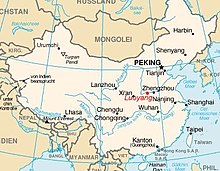Erlitou culture
The Erlitou culture ( 二 里頭 文化 / 二 里头 文化 , èrlǐtóu wénhuà ) is what archaeologists call an urban society from the Early Bronze Age that existed in China from 2000 BC. BC to 1500 BC Existed. The culture was named after the site that was discovered in Erlitou Village (二 里頭 村) of Yanshi City , in the administrative area of Luoyang City, Henan Province . The culture was widespread throughout Henan, centered there, and in Shanxi Province . It later expanded into Shaanxi and Hubei Province . Most Chinese archaeologists identify the Erlitou culture as the site of the Xia dynasty , while most western archaeologists are not convinced of the connection between the Erlitou culture and the Xia dynasty as there are no written records showing the Erlitou Culture linked to official historiography.
Culture
Erlitou was the largest settlement in China and even East Asia until around 1500 BC. Currently, to this day, it is the earliest confirmed capital of China with palace buildings and bronze- melting workshops. The Erlitou culture may have developed from the breeding ground of the Longshan culture . There is also a controversial connection with the controversial Xia dynasty: It is claimed that Erlitou may have been the Xia capital, Zhēnxún.
archeology
Discovered in 1959, Erlitou is the largest site associated with the Erlitou culture. Erlitou monopolized the production of ritual bronze vessels.
After the rise of the Shang Dynasty , the Erlitou facility shrank very much, but remained inhabited during the early phase of the Shang Dynasty. The (big) city lies on the Yi He , a tributary of the southern Luo He river. The city was about 2.4 km by 1.9 km; however, only 3 km 2 are left due to flooding damage. The palaces are in the southeastern section of the city. Palace 3 is of particular interest; it consisted of 3 inner courtyards along a 150 m axis.
chronology
- Erlitou Phase I (100 ha)
- Erlitou Phase II (300 ha) - A palace area of 12 ha was delimited by four streets. It contained the 150 × 50 m Palace 3 and Palace 5. - South of the palace complex was a bronze foundry.
- Erlitou Phase III (300 ha) - The palace complex will be surrounded by a 2 m thick rammed earth wall and Palaces 1, 7, 8 and 9 will be built. Palaces 3 and 5 are being abandoned and replaced by Palaces 2 and 4, which are 4200 m 2 in size.
- 1564–1521 BCE Erlitou Phase IV (300 ha) - Palace 6 is built as an extension of Palace 2. Palaces 10 and 11 are built.
- 1600-1450 BC Early development phase - decay sets in.
- 1450–1300 BCE Late Erligang phase (30 ha) - Erlitou becomes a village again, all palaces are abandoned.
See also
- Erligang culture
- List of Neolithic Cultures in China
- Great Emperor of China
- Xia Dynasty
- Xia-Shang-Zhou chronological project
literature
- Li Liu: The Chinese neolithic: trajectories to early states (The Chinese Neolithic: Paths to Early States) . Cambridge University Press, 2004, ISBN 0-521-81184-8 , p. 310.
- Allan, Sarah, Erlitou and the Formation of Chinese Civilization: Toward a New Paradigm , The Journal of Asian Studies, 66: 461-496 Cambridge University Press, 2007
- Li Liu, Xu, Hong: Rethinking Erlitou: legend, history and Chinese archeology (Rethinking Erlitou: legend, history and Chinese archeology) . In: Antiquity, . 81, No. 314, 2007, pp. 886-901.
- Jinhui Li: Stunning Capital of Xia Dynasty Unearthed . China Through a Lens. November 10, 2003. Accessed 2009-02-03.
Web links
- Andreas Lorenz: Palace under corn stalks. In: Der Spiegel 5/2002 of January 28, 2002, p. 178ff
- The Cultural History of China - 3. The Xia Dynasty by Dr. Eduard Tripp, A-1120 Vienna ( Memento from September 9, 2007 in the Internet Archive )
Individual evidence
- ↑ Allan 2007; Liu & Xu 2007
- ↑ Allan 2007; Liu 2004; Liu & Xu 2007
- ^ Li, 2009
- ^ Li, 2009
- ^ Li, 2009
- ^ Liu, 2007
Coordinates: 34 ° 42 ′ 6.33 " N , 112 ° 41 ′ 49.48" E

